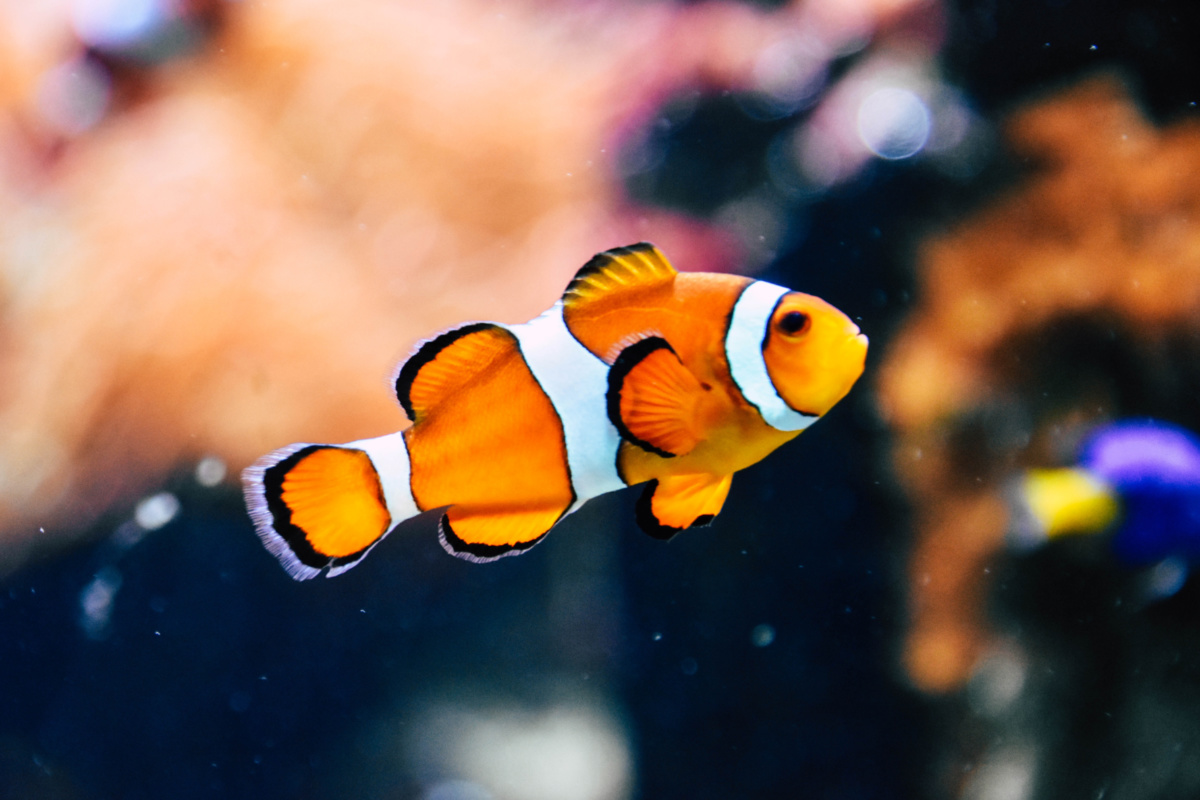
WILLIAM PERRY, of Cardiff UNiversity’s School of Biosciences, looks – in an article first published on The Conversation – at what the data shows…
While the environmental impact of having dogs and cats as pets has been examined to some extent, the impact of keeping pet fish has remained unexplored – until now.
Dogs in particular have a significant carbon “pawprint”. An average-size dog (weighing 10 to 20 kilograms) in Europe is responsible for between 349 and 1,424 kilograms of CO2-equivalent emissions per year – compared with between 150 kilograms and 251 kilograms of CO2-eq for an average-size cat (weighing two kilograms to six kilograms).

One of the most popular species of fish found in tropical marine aquariums is the common clownfish (Amphiprion ocellaris). PICTURE: Rachel Hisko/Unsplash
But there had never been a study examining the carbon footprint of pet fish, despite four million households owning them in the UK alone – 70 per cent of which are tropical freshwater fish.
My study found the carbon footprint of a tropical aquarium in the UK ranges from 85.3 kilograms to 635.2 kilograms of CO2-eq per year – equivalent to between 1.6 per cent and 12.4 per cent of the average UK household’s annual emissions. This estimate is based on a range of scenarios including aquarium sizes between 50 and 400 litres and different tank operating conditions. But most household aquariums sold by retailers are in the 50-to-100 litre range.
“Electricity generation is the main source of emissions from tropical aquariums. Maintaining one requires lots of electricity to power the heaters, lights and pumps. This electricity consumption is much greater in emissions terms than the CO2 produced in transporting tropical fish from countries such as Singapore or Indonesia to the UK and Europe.”
Electricity generation is the main source of emissions from tropical aquariums. Maintaining one requires lots of electricity to power the heaters, lights and pumps. This electricity consumption is much greater in emissions terms than the CO2 produced in transporting tropical fish from countries such as Singapore or Indonesia to the UK and Europe.
However, the precise carbon footprint of an aquarium varies depending on its location. For example, tropical fish kept in France have a much smaller carbon footprint than those kept in the UK, because the French electricity grid is more decarbonised.
This also means that as electricity grids continue to decarbonise globally, and especially in Europe, the carbon footprint of keeping tropical fish will decrease.
Water consumption
Water consumption is another factor to consider. Tropical aquariums are closed systems so fish waste can build up, increasing the levels of ammonia which is deadly to fish. So, fishkeepers must perform regular water changes – which means replacing the aquarium water with treated tap water or, for marine fish, water that has been purified using reverse osmosis (whereby water is pushed under pressure through a semi-permeable membrane). However, reverse osmosis is not efficient and produces five litres of reject water for every one litre of purified water.
Estimates of water consumption for tropical aquariums vary depending on aquarium size, use of reverse osmosis, frequency of water changes and amount of water replaced. Based on industry recommendations and a range of aquarium sizes, I estimated that tropical aquariums can use anywhere between 156 and 31,200 litres of water per year.
For example, if you have a 50-litre aquarium and you change six per cent of the water every week with tap water, you would use 156 litres per year. But if you have a 400-litre aquarium and do a 25 per cent water change every week with a reverse osmosis system, you could use up to 31,200 litres per year.
Clearly, these examples represent two extremes of water consumption, equivalent to between 0.2 per cent and 30.1 per cent of the average UK household’s annual water use. While the upper limit can sound alarming, most aquariums sit in the middle range by both water use and emissions. But, given that drought events are expected to increase under future climate scenarios, any additional levels of water consumption can quickly become unsustainable.
Context is also important, as estimates on energy consumption are based on the aquarium being in a 20 degree Celsius room. If a central heating system is on all day or it is a warm summer’s day, this will reduce the emissions generated from heating the aquarium. Alternatively, if the room is colder than 20 degrees, those emissions will be higher – although the heat from the aquarium will also heat the room, so may be viewed as an electric radiator.
We rely on our readers to fund Sight's work - become a financial supporter today!
For more information, head to our Subscriber's page.
Ways to reduce environmental impact of pet fish
My estimates provide the first insights into the environmental impact of a popular hobby. They show that keeping tropical fish is generally a more environmentally friendly option than keeping a dog or even a cat.
They can also inform our decisions on how to reduce the environmental impact of keeping fish, such as:
1. Use renewable electricity, generated at home or by changing electricity provider.
2. Keep the water temperature as low as possible according to species guidelines.
3. Put aquarium lights and pumps on timers.
4. Only do water changes when necessary; and
5. Re-use the reject water both from your aquarium and the reverse osmosis system.
Keeping tropical fish is a great way to enjoy beautiful ecosystems in your home. Done correctly, it can also help prevent the world from becoming a little bit more tropical.
![]()
William Perry is a postdoctoral research associate at the School of Biosciences, Cardiff University. This article is republished from The Conversation under a Creative Commons license. Read the original article.






